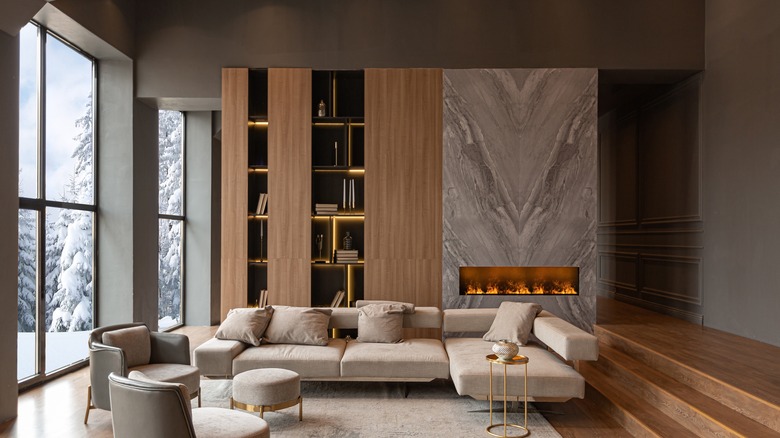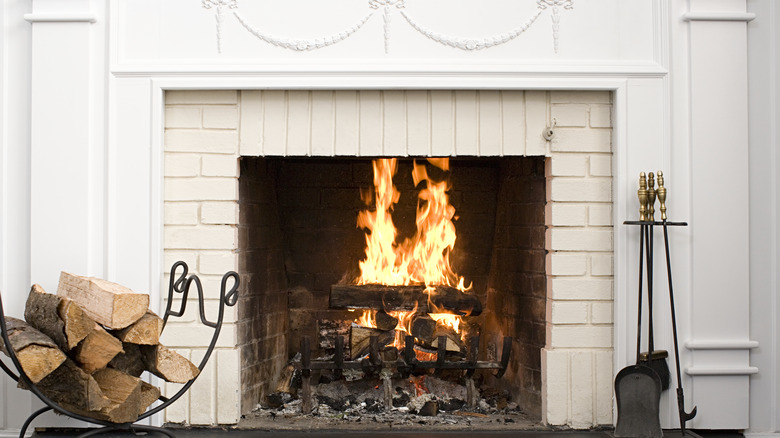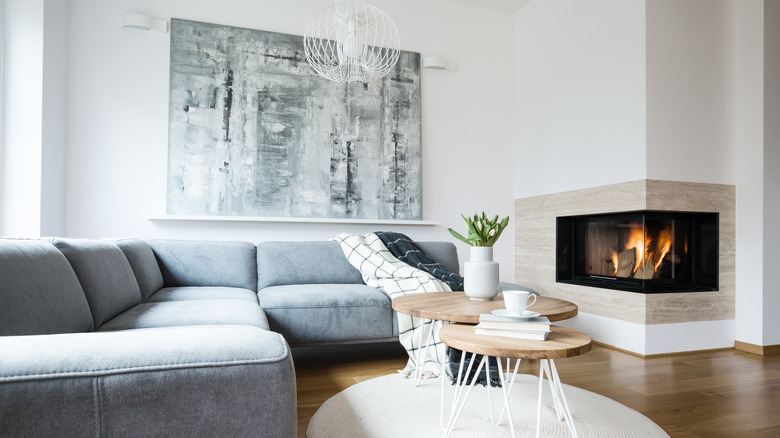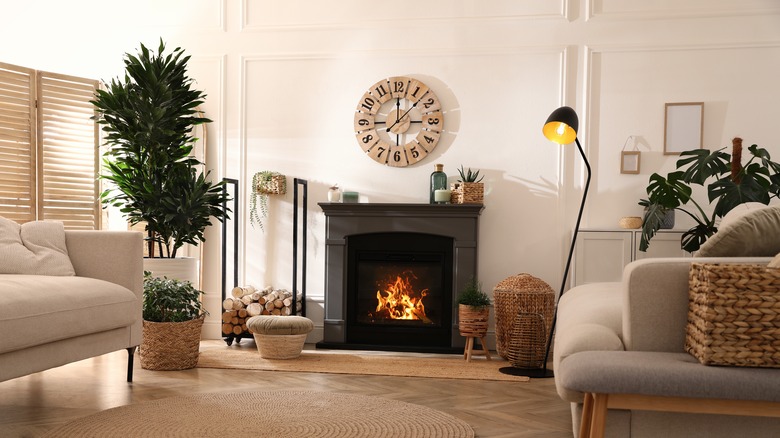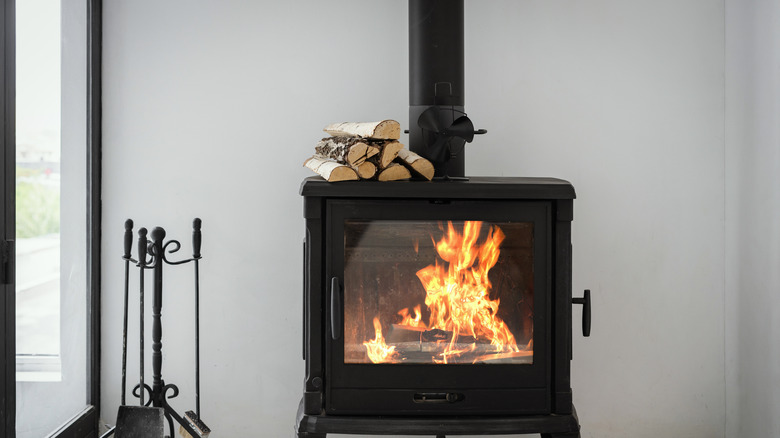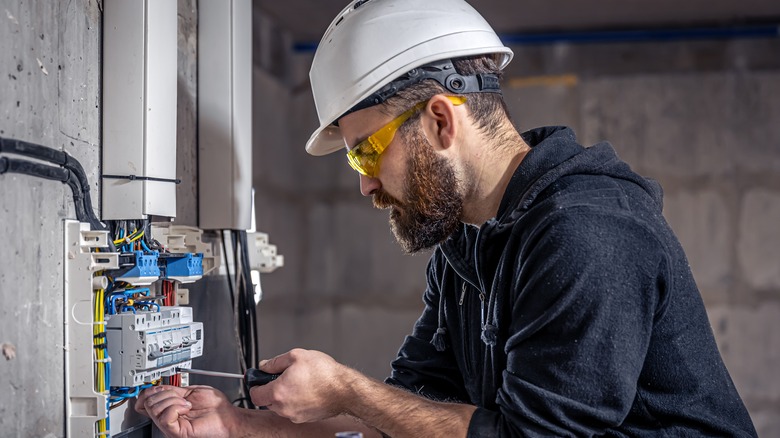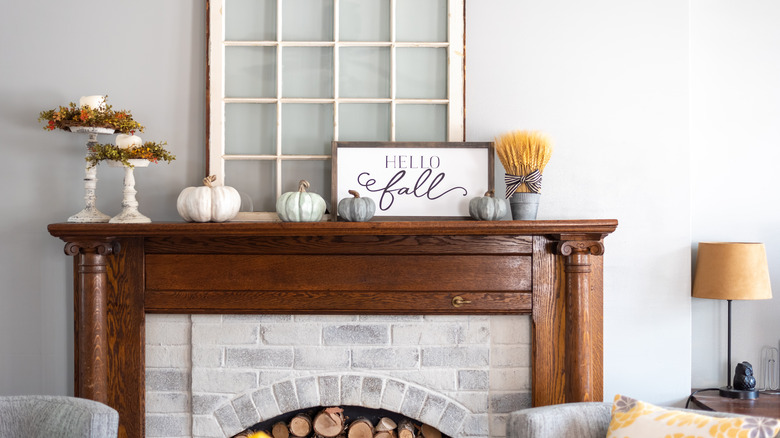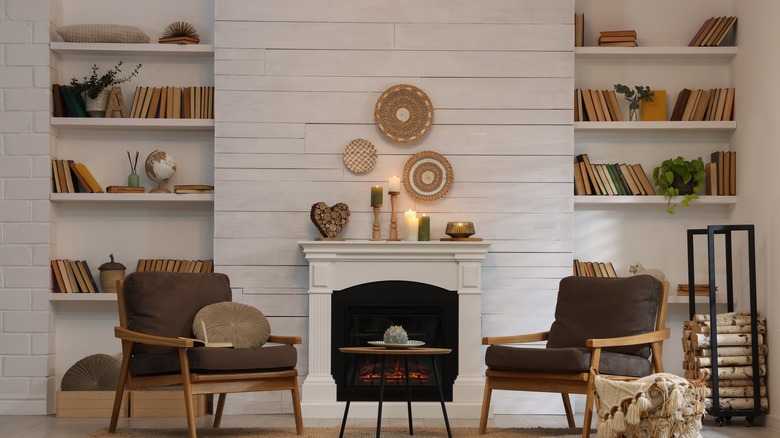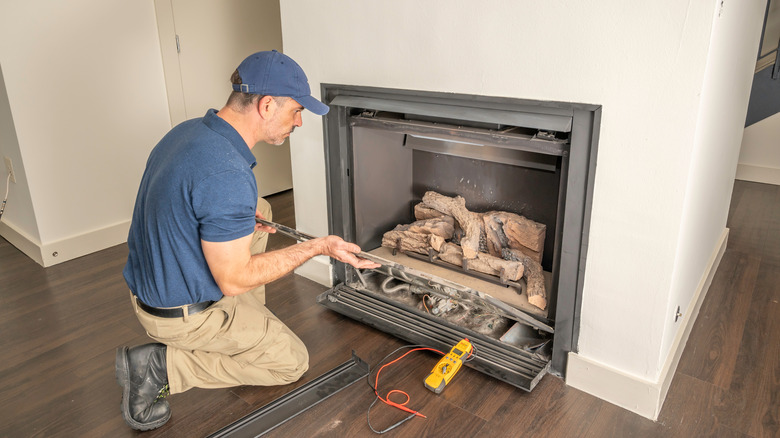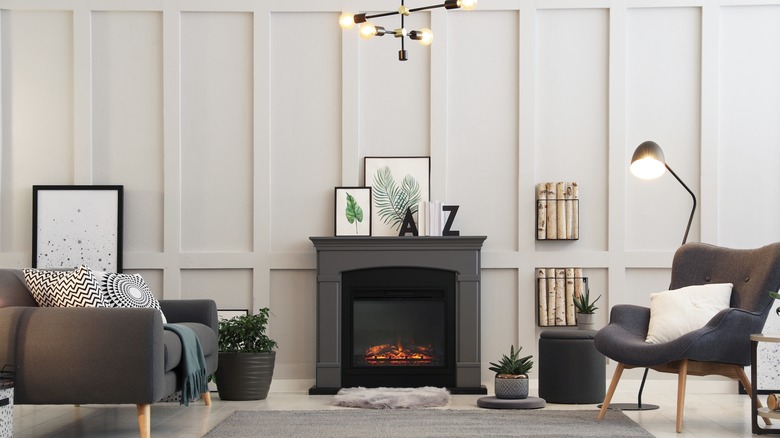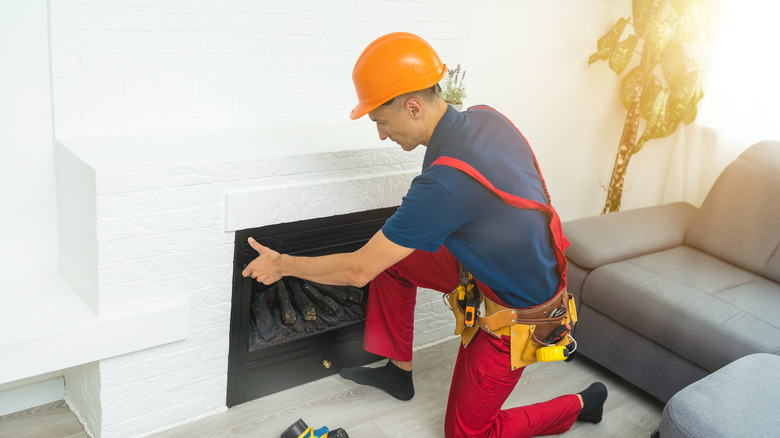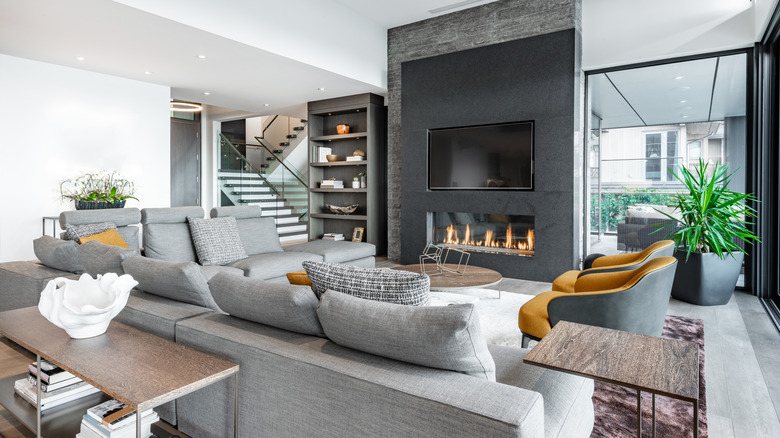Things To Keep In Mind Before Adding A Fireplace To Your Home
There are several benefits of having a fireplace in your home. They can help you stay warm on a cold winter's night, create a cozy and welcoming ambiance, provide another area to decorate, and so much more. Fortunately, if your home doesn't already have a fireplace — or you would like a second fireplace in another room — it is possible to add one. However, before you finalize the decision to add a fireplace to your home, there are several key things you'll need to understand and consider.
You'll want to think carefully about where to put the fireplace and decide which type of fireplace will work best based on your home's layout and your specific preferences. But, beyond those decisions, you'll also want to consider safety, your budget, and how to make sure that the fireplace enhances the room's visual appeal. Learn more about these and other key considerations to help you decide whether adding a fireplace to your home is the right decision.
What type of fireplace do you want?
One of the first things you'll want to think about is the type of fireplace that you would want to add to your home. There are actually several different options to choose from, so leave yourself some time to really dive into the pros and cons of each type of fireplace to help you make a decision that you'll be happy with. When many people think of a fireplace, their mind goes to a traditional wood-burning fireplace. As their name implies, this type burns real wood logs, venting the smoke through a chimney in the roof. Other than supplying the logs, you won't have to pay anything to operate the fireplace.
However, while wood-burning fireplaces have been around for centuries and are still found in many homes, they are far from the only option to consider. There are several types of gas fireplaces you might want to add to your home. Gas fireplaces, which do not need a chimney, can be controlled by flipping a switch or pressing a button. Propane or natural gas is responsible for igniting the flames, which will not create smoke or ash like you'd get with a wood-burning model.
Finally, there are also several electric fireplaces on the market. While these models can produce heat and light, they won't have a true flame that you'll find with a gas or wood-burning fireplace. Depending on your preferences, you may find that an artificial flame is sufficient to provide the ambiance you're looking for.
Where will you put the fireplace?
Another important thing to think about is where in your home you want the fireplace to go. One of the most common locations for a fireplace is in the living room or family room where it can be enjoyed by everyone in the home. When you choose such a central location, there will be ample space for everyone in the home to gather around the fireplace together and enjoy the warmth it offers. However, you may also be considering adding a fireplace to a less traditional location, such as your bedroom, dining room, or home office.
Once you've determined which room in the home you want the fireplace in, the next step is to decide where in the room you want it to go. Along a wall is the most common placement, but it isn't the only option available. Depending on the type of fireplace you choose, you could also potentially use it to create a division between different rooms in your house, suspend it from your ceiling, or opt for a corner fireplace. Don't forget, you can even build outdoor fireplaces to help make the time you and your friends and family spend outside even more enjoyable.
Do you have enough space for a fireplace?
Before finalizing your decision about where you want to have your new fireplace installed, you will need to verify that you have enough space for it. Start by considering the size of the room and the length of the wall where you want the fireplace to go. If your room is on the smaller size — about 140 square feet or so — then a width of 2 to 3 feet should be good. However, if you have a larger living room or family room, then you will likely want the fireplace to be between 3 ½ and 6 feet wide. If the dimensions are too far off from these, it may look out of place in the room and like it doesn't really belong.
The type of fireplace you desire will impact how much space you'll need to leave around it to minimize the chance of a fire. Electric fireplaces are less of a fire hazard and won't need too much additional clearance around the front and sides. However, with a wood-burning fireplace, you'll want to keep items farther away to prevent flying ashes or sparks from igniting them. National Fire Codes state that anything flammable must be a minimum of 6 inches from a fireplace opening. If any combustible materials protrude from the fireplace, more clearance is needed (one additional inch of clearance for each ⅛ inch that combustible materials protrude from the opening).
How will the smoke exit your home?
One benefit of choosing an electric fireplace over a gas or wood-burning model is that you will not create a path for the smoke to exit your home. Electric models run only using electricity; no fuel is burned and no harmful emissions are produced. However, the same is not true for their gas or wood-burning counterparts. Both of these fireplace types will need to be properly vented to ensure that the smoke and any other emissions safely exit your home.
Gas models can be vented either horizontally or vertically through an exterior wall or the roof of the home. A horizontal venting approach (known as direct venting) out of the side of the home is typically the easiest and least expensive option, but it may not always be a choice if you're not putting the fireplace along an exterior wall. With a wood-burning fireplace, the only safe option is to vent through the roof.
Do you need to add electrical wiring or a gas line?
Venting is not the only thing you might need to add to your home to be able to install a fireplace. Depending on the type of fireplace you want, where you want to have it installed, and which utilities you already have in place, you might also need to hire a professional to add electrical wiring or a gas line. If you're installing an electric fireplace, the best choice is to have an electrician create a dedicated circuit for it. This will lessen the chances of overloading a circuit and blowing a fuse.
If you are thinking about a gas fireplace, but your home doesn't already have an existing gas line, you'll need to have one run before you'll be able to get your fireplace up and running. You will need to hire a professional company to complete this task; it is not one that you'll be able to do on your own. They'll help you determine the appropriate size and placement for the gas line based on the specific fireplace you've selected.
Will you add a mantel to the fireplace?
While many fireplaces have a mantel, it isn't necessary to add one. However, there is a reason why mantels and fireplaces are so commonly paired together. Because we're all so used to seeing mantels above a fireplace, it may look off if you do not add one in your renovation. The area could end up looking like something is missing. There are also more practical reasons to consider adding a mantel above your fireplace. Decorating a mantel can add personality to your space. They provide a flat surface where you can display family pictures, seasonal decorations, and more.
If you decide that you would like to add a mantel, the next step is to decide on the size and style that you would like. You want the mantel to be wider than the fireplace, hanging over by 3 to 6 inches on either side (so a total of 6 to 12 inches wider). Also consider how deep you want it to be, making sure it is deep enough to hold your items, but not so deep that it looks off in the room. 6 to 7 inches is a good depth for most mantels.
Next, decide whether you'd prefer a floating mantel (which is just a shelf placed above the fireplace) or a surround, which includes a frame around the fireplace in addition to the shelf above it to hold items. There are also several different mantel styles — from traditional to rustic to modern — to compare, along with different wood materials and stain or color finishes. Think about your overall design goals to help you choose a mantel that will deliver a coordinated and attractive look to your space.
What will you do to make the fireplace a focal point in your room?
Adding a mantel is one way to draw attention to a fireplace. However, there is more you can do to pull the space together and really make your new fireplace the focal point of the room. First, consider how you'll decorate the mantel. Choose a few key pieces of artwork — either framed paintings or family photos, sculptures, or other statement pieces — that will catch the eye of anyone in the space. Another idea to help you achieve the goal of making your fireplace the focal point in your space is to be purposeful with lighting. Adding some recessed lighting above it that will illuminate the mantel itself and any decorations you place on it will help focus everyone's attention on the fireplace.
You could also consider turning the wall that holds the fireplace into an accent wall. Opt for a color that contrasts with what is on the rest of the walls, to help pull everyone's attention to the new addition to your space. Instead of painting the wall, you may also decide to add a patterned or textured wallpaper or even faux stone tiles to the wall.
One change you can make doesn't involve doing anything to the fireplace area itself. Instead, rearrange your furniture so that it faces the fireplace. When people are sitting down to have a conversation, their eyes will naturally go to the fireplace in front of them.
How much will installing the fireplace cost?
Gaining an understanding of what installing a new fireplace will cost is also important before committing to this change. You'll want to weigh the installation costs with the benefits of adding the fireplace to your home, along with your budget and what you can comfortably afford. There are several factors that can impact the total cost of having a fireplace installed. These can include the type of fireplace you purchase, the ventilation it will need, and whether you'll need to have any gas lines run to your home or any electrical work completed.
The cost to install a new fireplace can range between $100 and $5,600. An electric fireplace is typically the less expensive option, ranging from $100 to about $2,200. Gas and wood-burning models are generally more expensive, costing between $2,300 and $4,000 for gas and $1,900 and $3,300 for wood-burning. These types are more expensive, in part because of the ventilation upgrades that you'll also need to add to your home.
Will adding the fireplace increase your home's value?
If you're on the fence about whether a fireplace is a worthy addition to your home, learning whether it will increase your home's value could help you decide whether installing one is worth it. According to an Angi study conducted a few years ago in 2016, adding a fireplace will result in an increased home value. The survey showed that over two-thirds of real estate agents classified fireplaces as valuable assets in a home. What's more, over three-fourths of potential buyers were willing to pay more for properties that included a fireplace.
Over half of the real estate agents who participated in the study said that the addition of a fireplace — either inside or outside of a home — would increase the property's value by at least $1,000, or possibly as much as $5,000. However, only about one-third of home buyers saw that same value in adding a fireplace. A quarter of potential buyers said that they would only pay $1,000 extra for a home with a fireplace, while nearly a quarter was not willing to pay anything extra for a home with a fireplace.
When you look at the small potential increase in value along with the higher costs associated with adding a fireplace, it is unlikely that you're going to recoup your costs. That said, you still might decide that adding a fireplace is worth the cost. If it is something you know that you will use and enjoy while you live in your home, the impact on the value of your property may not even factor into your decision.
Do you need a permit to install the fireplace?
Permit requirements can vary based on your state and local government regulations. That being said, it is likely that you will need to apply for a permit if you are installing either a gas or wood-burning fireplace. Most local jurisdictions require homeowners to apply for a permit if they are making any structural changes to their property, such as those affecting the walls or roof. Because wood-burning fireplaces require a chimney through the roof and gas fireplaces must be vented through an exterior wall or the roof, permits will most likely be required. Moreover, any work with gas lines will also likely require a permit.
Depending on the type of electrical work that will need to be completed to install an electric fireplace, a permit may or may not be required. Before completing any major home improvement projects, it is always a good idea to check with your local permitting office to verify whether you will need to apply for a permit. This way, all of your bases will be covered.
How will adding a fireplace impact your electric bill?
If you're looking into adding a fireplace to your home, you may be curious whether you'll reap any benefits on your electric bill. This is a logical question to be asking. After all, fireplaces are designed to generate heat, which in theory should help reduce the amount of energy you use to heat your home with an HVAC system or furnace.
The answer to these questions will depend on the type of fireplace you're looking at having installed. A wood-burning fireplace won't do much to help lower your energy costs. Sadly, much of the heat that they produce goes out through the chimney and doesn't spread throughout the home. Gas fireplaces are also not going to do much to lower your energy costs. As much as 75% of the heat they create is also lost, rather than being distributed throughout the room.
If you have an existing wood-burning fireplace, having a gas insert installed will be a more energy-efficient option. They only lose about 20 to 30% of the heat that is generated. There is one option that is even more efficient than a gas insert, though. With an electric fireplace — which only consumes as much energy as a space heater — only 1% of the generated heat is lost. Unfortunately, electric modes may also give a false reading to your thermostat, which won't help with maintaining energy efficiency throughout the home.
